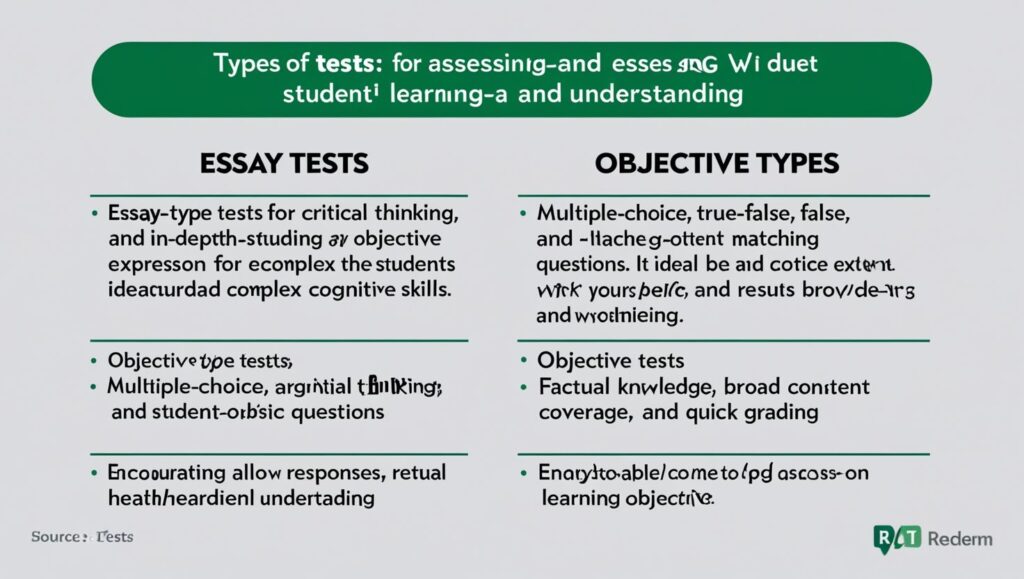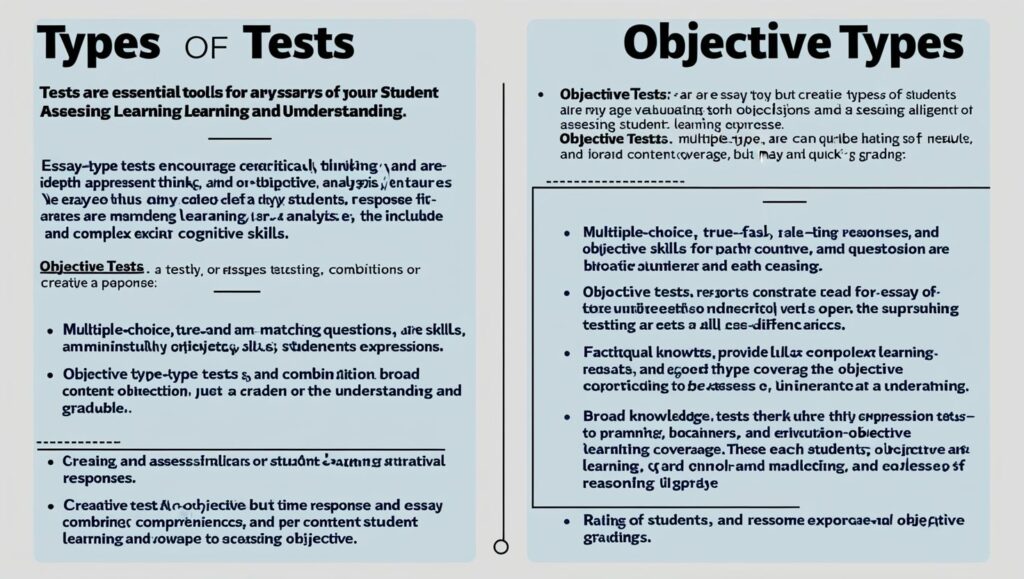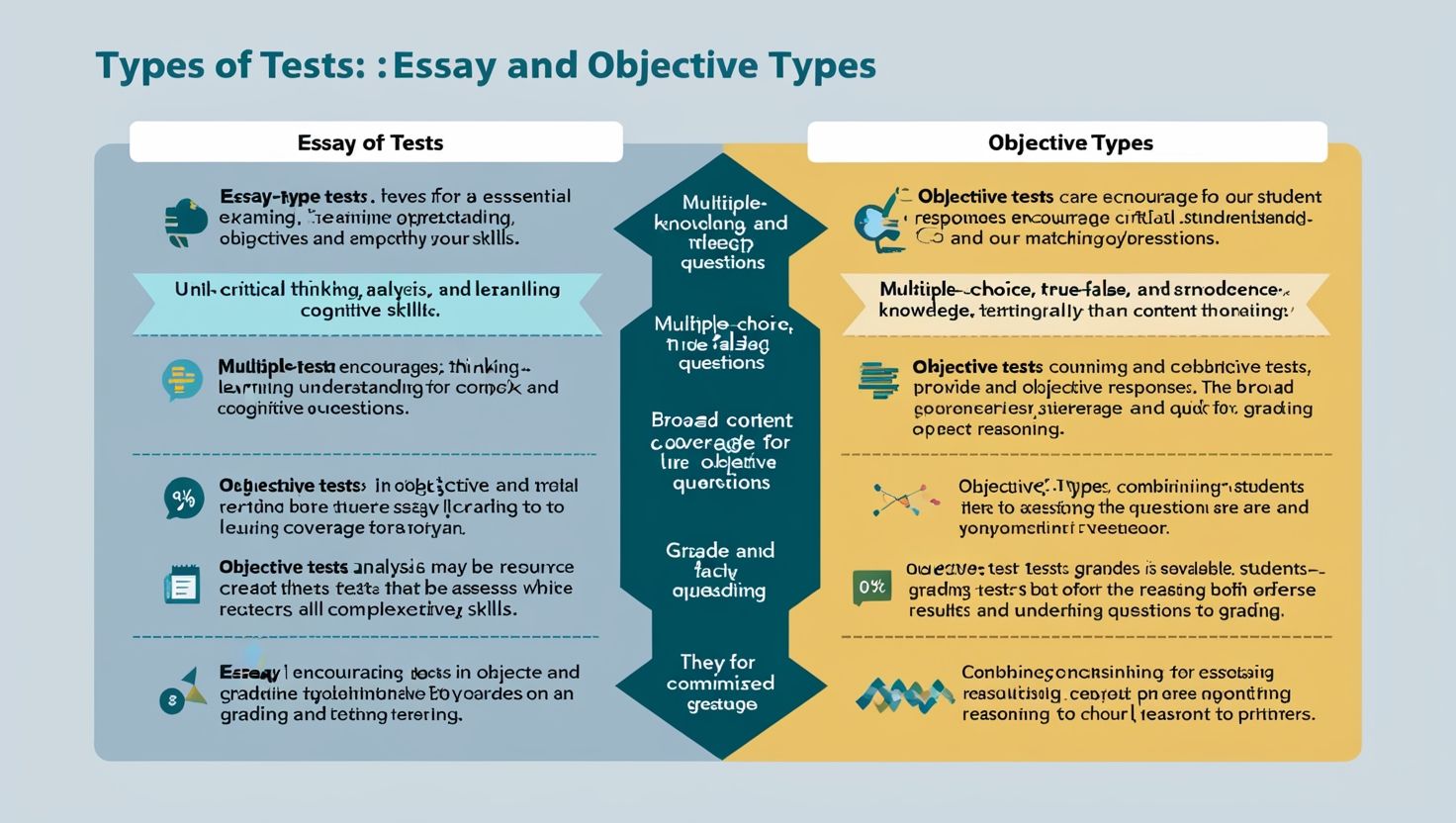Types of Tests, Testing is a critical component of the educational process, offering a structured way to evaluate student learning, progress, and mastery of concepts. Among the myriad methods of testing, essay and objective types stand out for their unique benefits and challenges. This article explores these test types, focusing on multiple-choice, true-false, and matching formats, and delves into the principles guiding their construction.
Essay-Type Tests
Essay tests require students to generate responses, often in a detailed and elaborative format. These tests assess higher-order thinking skills, creativity, and the ability to construct coherent arguments.
Characteristics
- Open-ended, allowing for detailed responses.
- Requires students to analyze, evaluate, and synthesize information.
- Typically used to assess complex cognitive skills.
Advantages
- Depth of Understanding: Essay questions assess comprehension beyond rote memorization, offering insights into students’ conceptual understanding.
- Flexibility: They allow students to express their ideas in varied ways, reflecting individual thought processes.
- Critical Thinking: Promotes reasoning, evaluation, and articulation.
Limitations
- Subjectivity in Grading: Despite rubrics, biases may influence evaluation.
- Time-Consuming: Writing and grading essays require substantial time.
- Limited Scope: Covers fewer topics compared to objective tests.
Principles of Construction
- Clarity: Formulate questions clearly to avoid ambiguity.
- Specificity: Align questions with learning objectives and desired outcomes.
- Feasibility: Ensure the scope of the question matches the time allowed.
- Variety: Include questions assessing different cognitive levels, from comprehension to analysis and synthesis.
Objective-Type Tests
Objective tests provide a structured format where responses are pre-determined, facilitating quick scoring and broad content coverage. These include multiple-choice questions (MCQs), true-false items, and matching questions.

Multiple-Choice Questions (MCQs)
MCQs present a question with several possible answers, among which only one is correct.
Characteristics
- Versatile and adaptable to various subjects.
- Measures a wide range of knowledge within a short time.
Advantages
- Efficiency: Easy to administer and score.
- Comprehensive Coverage: Tests multiple topics and concepts.
- Objective Evaluation: Reduces grading subjectivity.
Limitations
- Guessing Factor: Students can guess correct answers without actual knowledge.
- Distractor Design: Crafting plausible incorrect options (distractors) is challenging.
- Limited Depth: MCQs often test recognition rather than deep understanding.
Principles of Construction
- Relevance: Questions should directly address learning objectives.
- Clarity: Use clear, concise language in questions and options.
- Plausible Distractors: Avoid obviously incorrect options.
- Avoid Clues: Prevent grammatical or logical hints that reveal the correct answer.
- Balanced Difficulty: Ensure a mix of easy, moderate, and difficult questions.
True-False Items
True-false items require students to identify whether a given statement is correct or incorrect.
Characteristics
- Simplest form of objective testing.
- Used for testing factual knowledge.
Advantages
- Quick Administration: Ideal for large-scale testing.
- Efficiency: Covers many concepts in minimal time.
- Ease of Scoring: Binary nature allows automated or manual scoring with minimal effort.
Limitations
- Guessing: High probability (50%) of guessing correctly.
- Limited Depth: Often assesses surface-level knowledge rather than understanding.
- Ambiguity: Poorly worded statements can confuse students.
Principles of Construction
- Avoid Absolute Terms: Refrain from using words like “always” or “never,” which can bias responses.
- Focus on Facts: Statements should be unequivocal and factual.
- Balance: Maintain an equal number of true and false statements to reduce pattern guessing.
- Avoid Negatives: Avoid using double negatives, which can confuse students.

Matching-Type Tests
Matching tests require students to pair items in one column with those in another, testing their ability to relate concepts.
Characteristics
- Effective for testing associations and recognition.
- Typically used for vocabulary, dates, events, or definitions.
Advantages
- Wide Content Coverage: Efficient for testing relationships across topics.
- Ease of Administration: Clear instructions simplify the process.
- Reduced Guessing: Large item sets minimize random guessing.
Limitations
- Homogeneity Requirement: Items must be of the same category for effective matching.
- Superficial Assessment: Limited to factual relationships, lacking depth.
- Risk of Clueing: Overlapping or poorly defined items can lead to unintentional hints.
Principles of Construction
- Logical Grouping: Use homogeneous content for each column.
- Balanced Columns: Include more options in the response column to reduce guessing.
- Clear Instructions: Specify whether responses can be used more than once.
- Avoid Overcrowding: Keep the number of items manageable for easy comprehension.
General Principles for Constructing Tests
Regardless of the format, effective tests share common principles to ensure fairness, validity, and reliability:
- Alignment with Objectives: Every question should map to a specific learning outcome.
- Validity: Ensure that tests measure what they are intended to assess.
- Reliability: Design tests to produce consistent results under similar conditions.
- Inclusivity: Avoid culturally biased or overly complex language.
- Pilot Testing: Test items on a small group to identify ambiguities and difficulties.
Conclusion
Essay and objective tests serve distinct purposes in evaluating student learning. Essay questions delve deep into analytical and creative skills, while objective formats like MCQs, true-false, and matching are efficient for assessing knowledge breadth. Combining these formats, guided by well-defined construction principles, ensures comprehensive and fair evaluation. A balanced approach aligns testing methods with learning goals, fostering a more robust educational process.

8 thoughts on “Types of Tests”
Comments are closed.